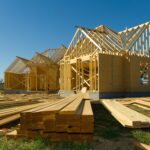Designing a custom home in Texas means more than just choosing the right floorplan or finishes—it means preparing for long, brutal summers. Instead of relying solely on air conditioning to battle the Texas heat, homeowners can benefit from passive cooling techniques that reduce indoor temperatures naturally. These strategies not only improve comfort, but they also lower energy costs and minimize environmental impact.
As custom builders, we incorporate these smart design elements from the ground up to ensure every home performs well—even in the hottest months.
Orient the Home to Maximize Shade and Airflow
Orientation plays a critical role in passive cooling. When you build with the sun in mind, you limit heat gain during peak hours. We position homes so that longer walls face north and south, minimizing direct sun exposure on east and west sides.
South-facing windows receive more controlled sunlight, which is easier to manage with shading. Meanwhile, placing smaller or fewer windows on the west side prevents intense afternoon heat from turning your home into an oven.
Additionally, we design floorplans that promote cross-ventilation. Strategically placing windows and doors allows breezes to flow through the home, pushing warm air out and pulling cool air in—even without mechanical systems.
Choose the Right Roof Color and Material
Roofing materials matter more than most people think. In the battle against the Texas heat, your roof stands on the front line. Dark-colored roofs absorb more heat, raising attic temperatures and forcing your cooling system to work harder.
We recommend light-colored or reflective roofing materials, such as metal or cool-rated shingles, which bounce sunlight away instead of absorbing it. This small change can drop attic temperatures by up to 30°F and significantly cut down on energy use.
Because Texas experiences strong sun for much of the year, the right roofing solution offers long-term savings and improved indoor comfort.
Add Deep Overhangs and Covered Porches
Shade remains one of the most powerful defenses against the Texas heat. We design homes with generous overhangs and extended eaves to block direct sunlight from entering windows—especially on south and west sides.
Covered patios, verandas, and porches further reduce solar exposure while enhancing outdoor living. These features not only shield windows but also help lower surrounding temperatures. Shaded exterior walls absorb less heat, which keeps your interior cooler.
In many Texas neighborhoods, deep overhangs also add visual charm and increase curb appeal.
Optimize Window Placement and Glazing
Windows bring natural light and ventilation—but without proper planning, they also let in a lot of heat. To fight the Texas heat, we carefully place windows to limit solar gain while maximizing airflow.
We use double-pane, low-E (low-emissivity) glass to reflect infrared rays and block harmful UV radiation. This type of glazing reduces indoor heat buildup while still allowing daylight to filter through.
We also consider height and alignment. High windows paired with lower ones promote natural convection, where warm air rises and exits through top openings, pulling cooler air through the lower ones.
Build in Ventilation Strategies That Work Naturally
Passive ventilation helps circulate air without mechanical assistance. We design homes with strategically placed vents, transom windows, and open floorplans to keep air moving throughout the day.
Attic ventilation also plays a major role. Ridge vents and soffit vents create a continuous flow of air through the attic, preventing trapped heat from radiating down into living areas. This simple but powerful feature can reduce attic temperatures and ease the load on your HVAC system.
Embrace Thermal Mass and Insulation
Thermal mass—like concrete, tile, or stone—absorbs heat during the day and releases it at night when outdoor temperatures drop. We incorporate these materials in floors or interior walls to help regulate indoor climate naturally.
However, thermal mass works best when paired with proper insulation. High-quality insulation in walls, attics, and floors prevents outside heat from entering while keeping cool air inside. Together, they provide a strong buffer against the Texas heat.
Build Smarter, Live Cooler in the Texas Heat
Beating the Texas heat starts with smart, passive design. By optimizing orientation, shading, airflow, and material choices, you can build a custom home that stays cooler with less energy. These techniques don’t just reduce monthly bills—they create more livable, comfortable spaces year-round.
If you’re ready to build a home that stands up to the Texas heat, let’s talk. Our team combines craftsmanship with climate-conscious design to deliver homes that look great, feel amazing, and work smarter—not harder.

